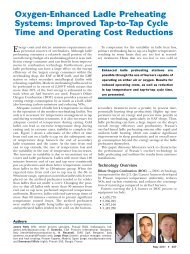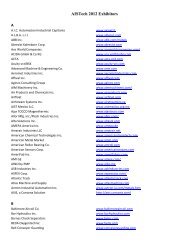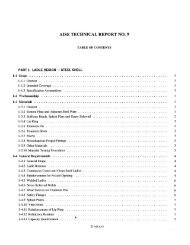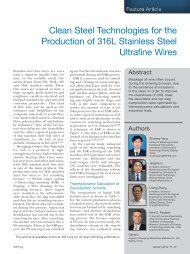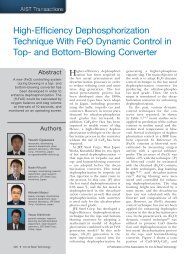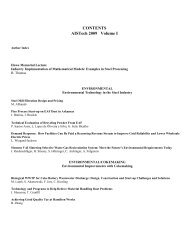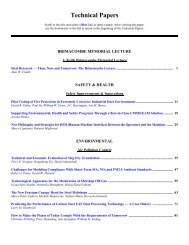Decarburization Efficiency in EAF With Hot Metal ... - Steel Library
Decarburization Efficiency in EAF With Hot Metal ... - Steel Library
Decarburization Efficiency in EAF With Hot Metal ... - Steel Library
Create successful ePaper yourself
Turn your PDF publications into a flip-book with our unique Google optimized e-Paper software.
Comparison of the performance results of the<br />
Shagang and Tianj<strong>in</strong> furnaces clearly <strong>in</strong>dicates that the<br />
hot metal charg<strong>in</strong>g method has rather significant <strong>in</strong>fluence.<br />
Slag door charg<strong>in</strong>g is a less favorable solution,<br />
mostly due to the uneven mix<strong>in</strong>g pattern of the liquid<br />
bath <strong>in</strong> the furnace, reduced reaction area and lower<br />
efficiency of the available chemical energy utilization.<br />
For the same share of hot metal <strong>in</strong> the charge, the<br />
specific energy consumption is about 20 kWh/ton<br />
higher, with a 2-m<strong>in</strong>ute power-on time <strong>in</strong>crease and<br />
consequent loss of productivity.<br />
Figure 6<br />
Figure 5<br />
CONSO <strong>in</strong>jectors layout and melt<strong>in</strong>g zone distribution (Tianj<strong>in</strong> <strong>EAF</strong> No. 2).<br />
CONSO <strong>in</strong>jector profiles dur<strong>in</strong>g melt<strong>in</strong>g (a) and superheat<strong>in</strong>g (b) phases (40% hot metal).<br />
Evaluation of <strong>Decarburization</strong> <strong>Efficiency</strong><br />
The furnaces presented <strong>in</strong> this paper were orig<strong>in</strong>ally<br />
designed for a reference charge configuration with a<br />
maximum 40% hot metal.<br />
The average decarburization rates of 0.12% C/m<strong>in</strong>ute<br />
were calculated to be achieved with average specific<br />
oxygen <strong>in</strong>jection rates of 300 Nm 3 /hour/m 2 of liquid<br />
bath surface, correspond<strong>in</strong>g to four CONSO lances<br />
operated at 2,000 Nm 3 /hour each.<br />
Consider<strong>in</strong>g that with 40% hot metal, the carbon<br />
content <strong>in</strong> the liquid bath is about 2% (1.7% C from hot<br />
metal and 0.3% C from scrap), the required cont<strong>in</strong>uous<br />
(a) (b)<br />
66 ✦ Iron & <strong>Steel</strong> Technology A Publication of the Association for Iron & <strong>Steel</strong> Technology



